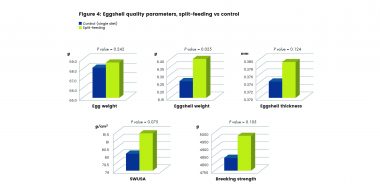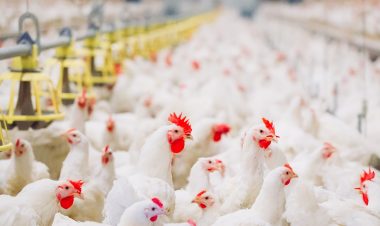Split-Feeding for broiler breeders improves hatching rates and welfare. Up to 2 more chicks per breeder hen can be achieved. Moreover, this system reduces feed costs and supports sustainability. It is the outcome of extensive research, conducted by Trouw Nutrition.
By Ad Bal
A split-feeding program for broiler breeders is putting conventional approaches to poultry nutrition in a new perspective. The split-feeding system has demonstrated improved hatching rates and lower feed costs in research centre trials and commercial farm studies.
The system delivers nutrients that support the birds’ requirements for egg formation at different times of day, as research conducted with laying hens shows birds’ circadian rhythms impact intake. Birds’ intake of protein and energy nutrients is higher in the morning when the egg yolk is produced, while calcium intake increases later in the day. These research insights inspired Trouw Nutrition scientists to develop feeding programmes so birds receive different nutrients at different times of day. Energy, protein and phosphorous to support egg-laying production are fed in the morning, and nutrients to support eggshell formation in the afternoon.
Performance and animal welfare benefits
The Trouw Nutrition broiler breeder studies conducted on their research facilities and on five commercial farms confirmed the performance, economic and animal welfare benefits of a split-feeding strategy. A series of research centre studies involving more than 2,800 broiler breeders compared performance parameters of hens fed a regular broiler breeder diet to hens receiving a split-feeding programme in the morning and afternoon. The split-feeding programme was designed to provide a more accurate nutrient supply, according to the egg formation need of breeders. This dietary strategy also provided less crude protein (CP), apparent metabolizable energy (AME) poultry, calcium (Ca) and digestible phosphorous (dP) compared to the control diet. Researchers evaluated egg production frequency, time spent eating, bird behaviour and eggshell quality.
Key findings of the research centre studies include:
- Increased egg production in birds, fed a split-feeding regime compared to the control group, resulting in higher total and hatching eggs, as well as higher chick production
- A significantly lower feed cost for birds fed the split-feeding system compared to birds receiving the control diet (Table 1)

- Birds receiving the split-feeding program demonstrated improved feathering, reduced pecking and showed fewer behaviours indicative of hunger
Research centre results were further confirmed by three concept tests of split-feeding programmes on commercial farms. Farm studies were conducted between May 2015 and November 2018, involving 122,600 Ross and Cobb breeders.
Key findings of the farm studies include:
- +1.9 chicks hatched in flocks fed the split-feeding programme compared to control (Table 2)

- A 9% reduction in feed costs (Figure 3), of 3-7% per hatched chick

- Flocks fed with split feeding also displayed significant improvements when it comes to eggshell quality. Eggshell quality parameters include weight, thickness, breaking strength and “shell weight per unit surface area” (SWUSA) values (Figure 4)

Environmentally responsible food production
Research findings further noted that as the efficiency of the split-feeding program means broiler breeder hens consume fewer nutrients, CO2 emissions are reduced up to 10%, resulting in less excretion of nutrients into the environment.
All in all, it can be concluded that split feeding brings breeders closer to their voluntary and physiological feeding behaviour. This system’s ability to address the nutritional requirements of broiler breeders supports efficient feeding, producer economics and farmers’ sustainability efforts.
















